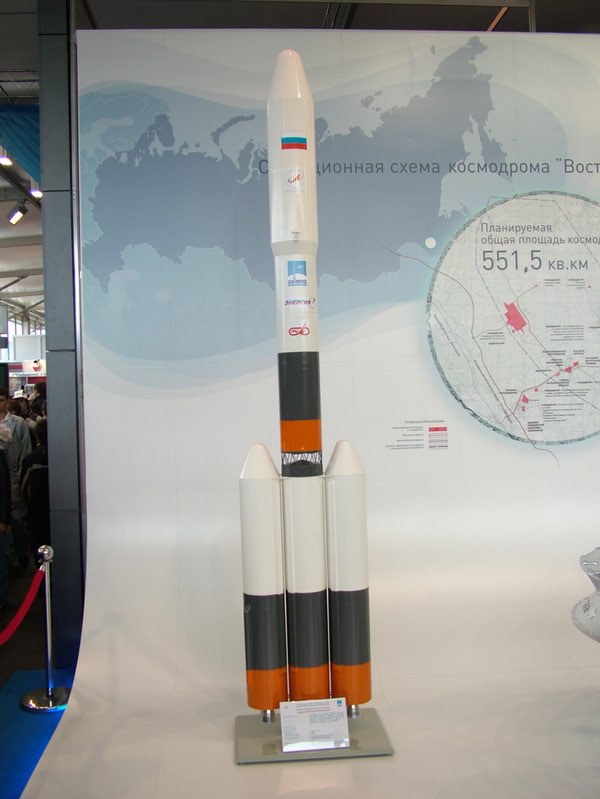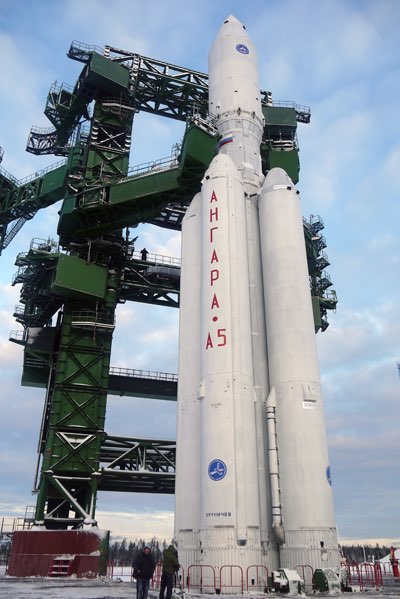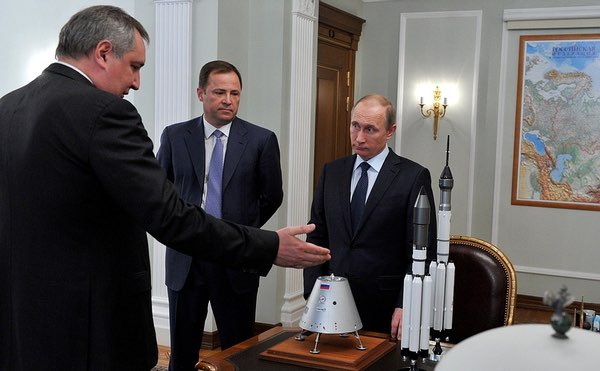The status of Russia’s human spaceflight program (part 2)Rocket conundrumFederatsia is way too heavy to be orbited by the Soyuz rocket, the only Russian launch vehicle to have placed cosmonauts into orbit since 1967. The original idea was to launch the spacecraft not only from the brand new Vostochny cosmodrome, but also with the help of a brand new launch vehicle, both of which existed only on paper. Conceived to minimize the country’s reliance on Baikonur in Kazakhstan, Vostochny was widely billed as Russia’s new gateway to the Moon and beyond. When the decision to build Vostochny was made in late 2007, the hope was to fly the first uncrewed mission from the cosmodrome in 2015 and the first crewed flight in 2018. In March 2009, RKK Energia won a tender to develop the new launch vehicle in collaboration with the Progress Rocket Space Center in Samara. Called Rus-M, it would consist of a first stage equipped with three RD-180 engines (the same engines used by the Atlas V) and a second stage using a new liquid oxygen/liquid hydrogen engine.
The new rocket never left the drawing board. While addressing the State Duma on the new course for the Russian space program in October 2011, Roscosmos’ newly-appointed chief, Vladimir Popovkin, stated there simply was no need for it. All of a sudden, the Russians seemed to remember they already had a rocket capable of launching the new spacecraft, namely the Khrunichev Center’s Angara-5, which had been under development for more than 20 years as part of a modular family of launch vehicles. In reality, Khrunichev had taken part in the 2009 tender for the rocket, but that had been no more than a formality. The specifications outlined in Roscosmos’ tender documents had been so obviously tailored to the RKK Energia proposal that Khrunichev stood no chance. Whatever motives had been behind that decision, it had clearly been flawed. Now, after almost three years of wasted time, it was as if the space agency was begging Khrunichev to come to the rescue. There were just two problems. One was that Angara’s sole launch pad was at the military Plesetsk Cosmodrome in Russia’s northwest, which is best suited for launches into high-inclination orbits. The other was that not a single member of the Angara family had flown yet, mainly due to delays in the construction of the Plesetsk pad. Although the choice of Angara-5 saved the Russians the cost of developing a new rocket, building a new pad for the rocket at Vostochny would be no less laborious than for the canceled Rus-M. There was no way the task could be finished by 2015, the deadline set by Putin for the first launch from the new cosmodrome, his second biggest prestige project after the 2014 Winter Olympics in Sochi. The solution that Popovkin offered during his Duma speech was to initially build a much simpler and cheaper pad at the cosmodrome for the Soyuz rocket, albeit only for unmanned missions. Only if the first Angara test flights from Plesetsk were successful would a decision be made to fly the rocket from Vostochny. With the Soyuz rocket already having two pads at Baikonur, two at Plesetsk, and one at Kourou in French Guiana, there was no real operational need for constructing yet another one at Vostochny, but at least it would spare Russia the embarrassment of experiencing multiple postponements in the inauguration of the prestigious launch site.
Following years of delays, the Angara family finally saw its first two flights from Plesetsk in 2014. A light version of the rocket flew a suborbital test mission in July of that year and the heavy Angara-5 placed a dummy payload into geostationary orbit in December. Meanwhile, in spite of countless corruption scandals, construction of the Soyuz pad and related infrastructure at Vostochny remained relatively well on schedule, leading to a maiden launch in April 2016, just a few months after Putin’s deadline. All this cleared the path for the construction of two adjacent Angara pads at Vostochny, but budget cuts forced the Russians in early 2016 to reduce that number to just one. The single pad should be able to support all versions of the Angara rocket and have a capacity of ten launches per year. The human-rated version of the rocket, called Angara-5P (P standing for “piloted”), is powerful enough to launch Federatsia on its first Earth orbital shakedown flights in the early 2020s. Sending the vehicle to the Moon in one go will require a rocket with a payload capacity of about 70 to 80 tons, the equivalent of NASA’s Space Launch System. Since such a rocket looks too expensive to develop in the short run, Roscosmos came up with an interim solution to fly Federatsia to the Moon in the second half of the 2020s. An uprated version of Angara with a payload capacity of 37 tons can handle the job with just two launches. Dubbed Angara-5V, it will be equipped with a liquid oxygen/liquid hydrogen third stage employing RD-0150 engines. It can also be used for launches of robotic satellites and deep space probes. A flight scheme devised in 2015 would see the first Angara-5V carry the 20-ton Federatsia into Earth orbit along with a modified LOX/kerosene Block-DM upper stage. That combination would then dock with a LOX/LH2 propulsion stage orbited by the second rocket and head for the Moon with translunar injection burns from both the cryogenic stage and the Block-DM. The Block-DM would also perform the lunar orbit insertion burn. After completing its mission, Federatsia would then light its own engines to leave lunar orbit and head back to Earth.
The decision not to build the second Angara pad at Vostochny has complicated the dual-launch scheme. Roscosmos launch vehicle director Aleksandr Medvedev said last year that the turnaround time between launches from a single pad will be at least seven to ten days, meaning much of the liquid oxygen in the Block-DM will boil off by the time the cryogenic stage arrives. A solution he offered was to equip Federatsia with a much bigger service module that would carry 18 tons rather than 6 tons of storable hypergolic propellants, which remain stable for an unlimited amount of time. This would enable it to take over all the functions of the Block-DM. However, RKK Energia chief Vladimir Solntsev has expressed skepticism about the idea, adding he is confident he can work out some kind of compromise with Medvedev. Earlier, Solntsev had even suggested to forego development of the Angara-5V altogether and instead speed up work on a heavy-lift launch vehicle (HLLV) to have it ready around 2025. Ultimately, the Russians will need an HLLV anyway if they want to realize their lunar ambitions. Flying a lunar landing mission with Angara-5V would require four launches of the rocket, which would be challenging enough even with two pads. Two companies, RKK Energia and the Progress Rocket Space Center, have been working on HLLV concepts for some time. The leading contender appears to be a rocket being designed by RKK Energia under the provisional name Energia-5VR. Having a payload capacity of about 100 tons to low Earth orbit, it has a core stage surrounded by four equally-sized strap-on boosters and a third stage on top. The company has tried to minimize the cost of the rocket by assembling it from building blocks used on other launch vehicles. The core stage and strap-on boosters, all burning liquid oxygen and kerosene, will also be the first stage of a new medium-lift rocket called Sunkar (a Kazakh word meaning “Falcon”). The third stage will be virtually identical to the cryogenic third stage of Angara-5V. At first sight, it is a clever scheme. All stages of the rocket should have been thoroughly tested well in advance and will be manufactured on a large scale for use on three different launch vehicles, significantly driving down costs. While NASA’s SLS uses many components inherited from the Space Shuttle, none of these elements will be flying in parallel on other launch vehicles. The Russian “lego” approach to building heavy-lift rockets will also make it possible to fly lighter and heavier variants of the rocket. By attaching either two or six strap-on boosters to the core stage, the payload capacity can be reduced to about 70 tons (the minimum requirement for a single-launch lunar orbit mission) or increased to 170–180 tons. Both Sunkar and Angara-5V are funded under FSP 2016–2025 and should pave the way for the development of the new HLLV. Sunkar is part of a research and development program called Feniks (“Phoenix”) initiated several years ago to produce an all-Russian reincarnation of the Ukrainian-built Zenit rocket. Initial efforts focused on a rocket called Soyuz-5 that would burn LOX and methane to achieve a nine-ton payload capacity. In 2015, the program was reoriented to a LOX/kerosene rocket capable of placing 17 tons into orbit. Sunkar’s first stage, slightly wider and longer than that of Zenit, will use a four-chamber RD-171M engine very similar to that flown on the Zenit first stage. Like that of Feniks, the Zenit first stage also served as the strap-on booster for a heavy-lift rocket, namely the Soviet-era Energia rocket flown twice in the late 1980s. The second stage will be equipped with a pair of RD-0124 LOX/kerosene engines already used by the Soyuz and Angara rockets and will provide significantly more thrust than Zenit’s single RD-120 engine. Sunkar will fly from the single surviving Zenit pad at Baikonur and will be used for commercial missions under a joint Russian-Kazakh venture called Baiterek (a word from Kazakh mythology meaning “poplar”). The rocket may also be acquired by Sea Launch, which was purchased last year by S7 Group, the largest private aviation holding company in Russia.
Russian officials have indicated that both Sunkar and Angara-5V may be ready to fly by 2025 or shortly thereafter. Timelines for the heavy-lift booster are much more vague. Reports last year suggested that the budget cuts in the Federal Space Program had delayed the first mission from 2030 to 2035. This corresponds to other information that construction of infrastructure for the booster at Vostochny, scheduled to begin around the mid-2020s, might take as long as ten years to complete. As for actual lunar missions beyond 2025, the latest target dates were given by RKK Energia general director Vladimir Solntsev at a conference in Moscow last November. An lunar fly-around of Federatsia is scheduled for 2026, an uncrewed landing of a lunar lander for 2027, an uncrewed lunar orbit mission for 2029, followed by a human lunar orbit mission in 2030 and a human lunar landing in 2031. It should be remembered though that RKK Energia has a history of setting more optimistic timelines than Roscosmos. If the heavy booster will indeed not become available until the mid-2030s, the early lunar landing missions will have to be flown with complex multiple launch schemes that look completely unrealistic. The first major task to accomplish is the construction of an Angara pad at Vostochny in time for Federatsia’s first mission in late 2021. A site for the pad (not far from the Soyuz launch complex) was reportedly selected last year, but the latest indications are that construction work will not start in earnest until the second half of this year or 2018. One factor that delayed the completion of the Soyuz pad at Vostochny was that blueprints were repeatedly changed while construction was already underway. Clearly, the Russians want to avoid a repetition of that problem this time around.
The Angara pad at Vostochny will not be a carbon copy of the one at Plesetsk. First, the Plesetsk pad was constructed on the basis of infrastructure that had already been built in the 1980s for the Zenit rocket. Second, the Angara pad at Vostochny will have to support crewed missions as well as launches of the newly conceived Angara-5V with its cryogenic upper stage. Another problem is that the Russian government has not yet made a decision on the level of funding for cosmodrome development in the coming ten years, even though it was supposed to have done so last spring. Cosmodrome development is funded under a program separate from the Federal Space Program. Vladimir Putin called for speeding up construction of the Angara infrastructure during another meeting with space officials last November. The meeting was intended to update the President on a new “development strategy for Roscosmos until 2030.” How that fits into the long-term strategy Putin signed in April 2013 is not entirely clear.
Dmitri Rogozin did state in mid-January that the strategy, to be submitted to the president this spring, should include important recommendations on the future of Russia’s human spaceflight program, taking into account the current international political situation. As usual, the Deputy Prime Minister did not mince his words, alluding this time to America’s reliance on Russian rocket engines : “We don’t only expect proposals from Roscosmos on ISS but also on human spaceflight as a whole. Who will we be working with? Will we maintain the cooperation that that we ourselves have defended despite the sanctions and the relentless desire of [Sen. John] McCain and other abnormal people in the [U.S.] Senate to saw off the very branch they’re sitting on by trying to stop the delivery of [Russian] rocket engines without which [their rockets] wouldn’t be able to fly?”. Just about two weeks after making this statement, Rogozin ordered the formation of a work group with the specific goal of plotting a course for Russia’s piloted space program until 2025 and beyond. As reported by the Izvestia newspaper, he assigned the task to Oleg Frolov, a member of the Military Industrial Commission. A Roscosmos spokesman interviewed by the newspaper expressed surprise that the job had been entrusted to an outsider. Still, Frolov is not a newcomer to the space program, having acted as first deputy head of the Russian space agency from September 2012 to October 2013. The work group will consist of specialists from TsNIImash, Roscosmos’ think tank, and the Foundation for Advanced Research Projects, set up in 2012 as the Russian equivalent of the US Defense Advanced Research Projects Agency (DARPA). Home |
|


